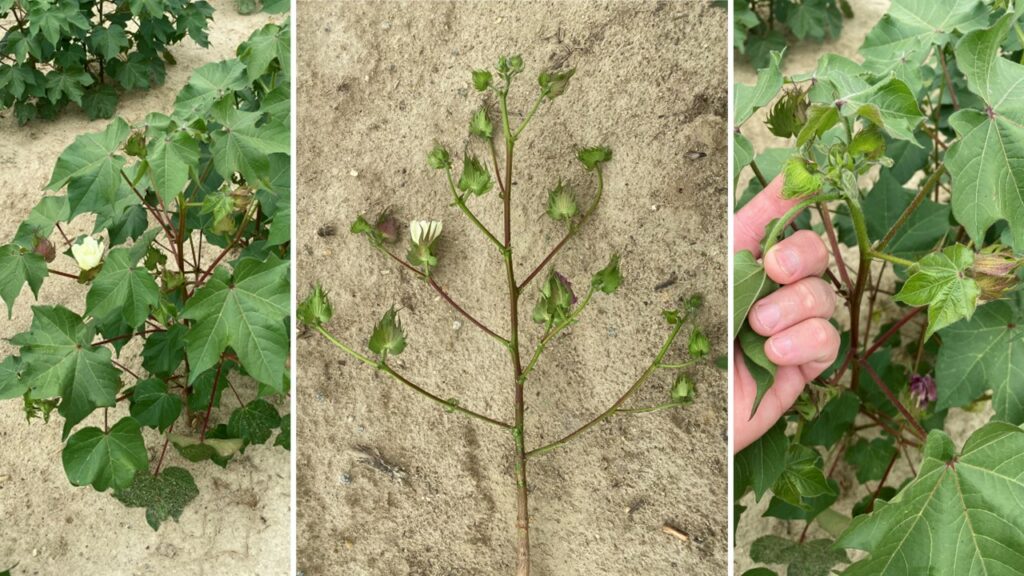Cotton Beginning to Bloom: Pay Attention to Growth!! (Collins & Edmisten)
go.ncsu.edu/readext?872059
en Español / em Português
El inglés es el idioma de control de esta página. En la medida en que haya algún conflicto entre la traducción al inglés y la traducción, el inglés prevalece.
Al hacer clic en el enlace de traducción se activa un servicio de traducción gratuito para convertir la página al español. Al igual que con cualquier traducción por Internet, la conversión no es sensible al contexto y puede que no traduzca el texto en su significado original. NC State Extension no garantiza la exactitud del texto traducido. Por favor, tenga en cuenta que algunas aplicaciones y/o servicios pueden no funcionar como se espera cuando se traducen.
Português
Inglês é o idioma de controle desta página. Na medida que haja algum conflito entre o texto original em Inglês e a tradução, o Inglês prevalece.
Ao clicar no link de tradução, um serviço gratuito de tradução será ativado para converter a página para o Português. Como em qualquer tradução pela internet, a conversão não é sensivel ao contexto e pode não ocorrer a tradução para o significado orginal. O serviço de Extensão da Carolina do Norte (NC State Extension) não garante a exatidão do texto traduzido. Por favor, observe que algumas funções ou serviços podem não funcionar como esperado após a tradução.
English
English is the controlling language of this page. To the extent there is any conflict between the English text and the translation, English controls.
Clicking on the translation link activates a free translation service to convert the page to Spanish. As with any Internet translation, the conversion is not context-sensitive and may not translate the text to its original meaning. NC State Extension does not guarantee the accuracy of the translated text. Please note that some applications and/or services may not function as expected when translated.
Collapse ▲There have been a few reports of cotton beginning to bloom across the state. This is expected from earlier, late-April planted cotton, whereas several slightly later-planted fields are expected to begin blooming soon.
PGRs are typically applied at this stage, or even to cotton of similar size but not yet blooming. The purpose of this article is to encourage you to pay attention to growth in each field before making the decision to apply PGRs. IT WOULD BE UNWISE to make careless PGR applications at this stage just because you may have done it in the past. MAKE SURE that a PGR application is warranted and necessary before making an application.
Below is a fairly common scenario we are seeing in earlier planted cotton that began blooming within the last week or so. Keep in mind that many areas have been dry, and that certainly has affected growth, even though we often think that cotton uses very little water during squaring (see previous article on Squaring Cotton Needs Watering). Similar growth can result from slow emergence combined with herbicide injury, dry weather, or stunting of any kind. Regardless of whether or not cotton has begun blooming or the degree of stunting, evaluate growth FIRST to ensure an application is needed.
The cotton illustrated below was planted in late April, began blooming about a week ago, and is now 20-22 inches tall. It has recently been side-dressed with recommended fertilizer and has received rain to activate that fertilizer. Moisture status is currently marginal, but there are no signs of wilting, nor has there been any.
Despite the fact that it has been blooming for only about a week, it is now 6 nodes above white bloom, which is below the point at which a PGR is needed (We typically advise NAWB>7 to justify a PGR application, among other factors). Furthermore, the main stem and branches are showing signs of reddening/toughening which can also be an indicator of stress of some sort. Lastly, the squares in the terminal are rather large, which is an indicator of prior stress or the rate of terminal growth is diminishing. If hot (90 degrees or higher) and dry conditions persist, the crop will reach cutout rather quickly (probably within another week), and will cease growing for the time being (until drought is alleviated by rain) or permanently (if dry conditions persist). The last thing it needs right now is a PGR application.
There is not much of a boll load on plants such as the one illustrated above. If sufficient rains occur (hopefully this evening), the situation could be quite different in a week or two. We need widespread rainfall to bring the plant out of this, and continued rainfall will be needed to sustain growth until an optimal height, optimal number of fruiting branches, and optimal boll load is reached.
There are a number of fields with perfectly normal and healthy growth. Those fields have received timely rains. But given the conditions we’ve experienced thus far, it would be futile to make PGR decisions solely based on habit or calendar date. PAY ATTENTION to plant growth and make appropriate decisions accordingly.



